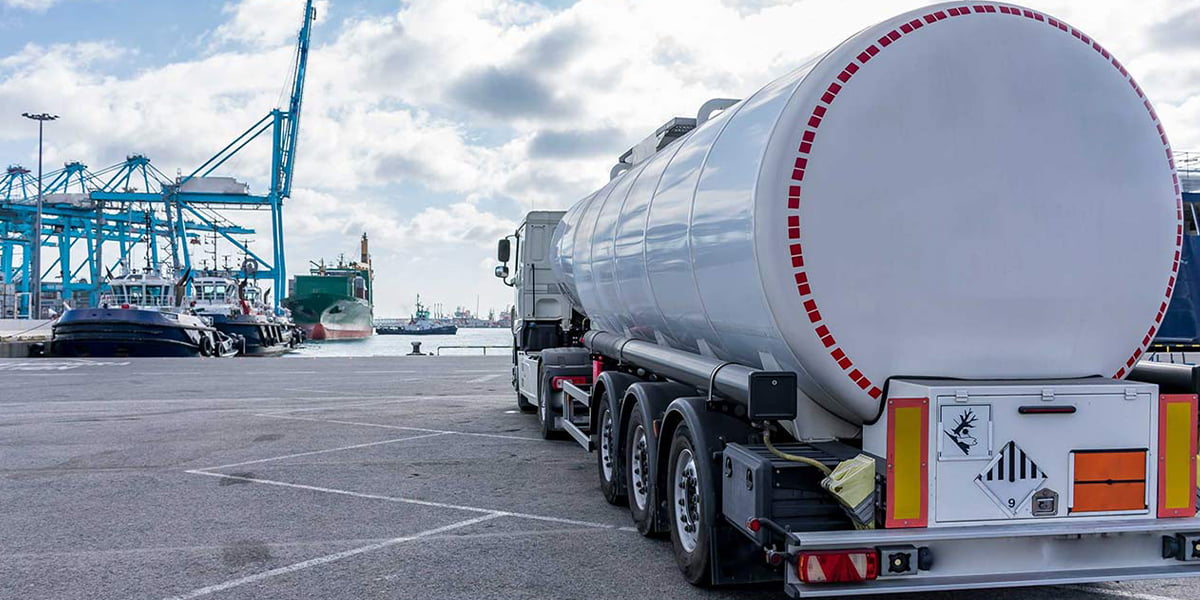
ADR (from French Accord Dangereuses Route) is a European agreement on the international transport of hazardous goods.
Hazardous goods are substances posing a risk of harm to health, human life and/or the environment during transportation. The transportation of hazardous goods, except for ADR, is regulated in accordance with the Temporary Instruction on the Transportation of Hazardous Goods by Road of the Ministry of Transport.
The ADR Agreement is valid in all EU countries, as well as in Kazakhstan, Azerbaijan, Morocco, Russia (similar name of ADR).
Hazardous goods by nature and degree of danger: classification
Class 1 are explosive materials that may explode or catch fire. And devices containing explosives and detonating means intended to produce a pyrotechnic effect;
Subclasses
1.1 – pyrotechnic, explosive substances/products with a mass explosion hazard (instantaneous coverage of the entire cargo);
1.2 – pyrotechnic, explosive substances/products that do not explode in bulk;
1.3 – pyrotechnic, explosive substances/products that have a fire hazard with or without a slight explosive effect;
1.4 – pyrotechnic, explosive substances/products that carry a slight risk of explosion during transportation only in the case of initiation or ignition, which do not destroy devices and packages;
1.5 – explosives with a mass explosion hazard that are so insensitive that initiation or transition from combustion to detonation is unlikely during transportation;
1.6 – articles containing substances insensitive to detonation and characterized by a low probability of accidental initiation;
*Explosive mixtures of gases, vapours and dusts are not considered as explosives.
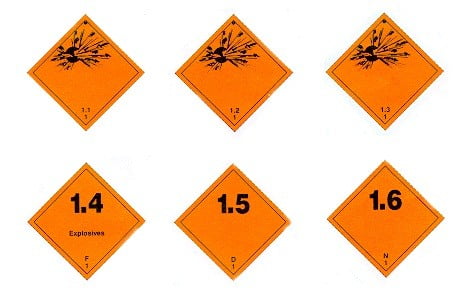
Class 2 are compressed, liquefied by cooling and dissolved under pressure gases that meet at least one of the following conditions:
- absolute vapor pressure at 50 °C is equal to or higher than 3 kgf/cm2 (300 KPa);
- the critical temperature is below 50 °C.
According to the physical state of gases are divided into:
- Brief. The critical temperature is below -10 °C;
- Liquefied. The critical temperature is equal to or above -10 °C, but not lower than 70 °C;
- Liquefied. The critical temperature is equal to or above 70°C;
- Dissolved under pressure;
- Liquefied by supercooling;
- Aerosols and compressed gases that are subject to special regulations.
Subclasses
2.1 – non-flammable gases;
2.2 – non-flammable poisonous gases;
2.3 – flammable gases;
2.4 – flammable poisonous gases;
2.5 – chemically unstable;
2.6 – chemically unstable poisonous.

Class 3 are flammable liquids, mixtures of liquids, as well as liquids containing solids in solution or suspension, which emit flammable vapors with a flash point in a closed crucible at 61 °C and below.
3.1 – flammable liquids with a low flash point and liquids with a flash point in a closed crucible below -18 °C or having a flash point in combination with other hazardous properties other than flammability;
3.2 – flammable liquids with a medium flash point – liquids with a flash point in a closed crucible from -18 to +23 °C;
3.3 – flammable liquids with a high flash point – liquids with a flash point from 23 to 61 °C inclusive in a closed crucible.
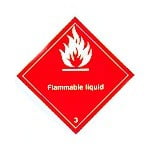
Class 4 are flammable substances and materials, other than those classified as explosives, which are capable of igniting during transportation from external sources of ignition due to friction, moisture absorption, spontaneous chemical transformations, as well as when heated.
4.1 – flammable solids that can ignite from short-term exposure to external ignition sources (sparks, flames or friction) and burn intencely;
4.2 – flammable substances that can spontaneously heat up and ignite under normal transportation conditions;
4.3 – substances that emit flammable gases when interacting with water.

Class 5 are oxidizing substances and organic peroxides, which can release oxygen, support combustion, and in certain conditions or mixtures with other substances cause spontaneous combustion and even explosion.
5.1 – oxidizing substances. They are not flammable in themselves, but contribute to the flammability of other substances and release oxygen during combustion, thereby increasing the fire intensity;
5.2 – organic peroxides. Most of them are flammable, can act as oxidizing agents and interact hazardously with other substances. Some of them are flammable and sensitive to impact or friction.
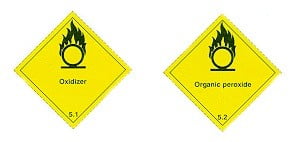
Class 6 are poisonous and infectious substances that can cause poisoning, disease or even death.
6.1 – poisonous (toxic) substances that cause poisoning when inhaled (vapors, dust), ingested or in direct contact with the skin;
6.2 – substances and materials containing pathogenic microorganisms that are hazardous for humans and animals.
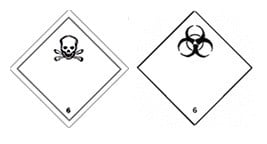
Class 7 are radioactive substances with specific activity over 70 kBq/kg (nCi/g).
Class 8 are corrosive substances that cause damage to the skin, eyes, respiratory tract, cause corrosion of metals and damage vehicles, buildings, cargoes, and can also create a fire when interacting with organic materials or certain chemicals.
8.1 – acids;
8.2 – bases;
8.3 – caustic and corrosive substances.
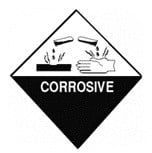
Class 9 are substances with a rather low hazard during transportation. They do not belong to any of the previous classes, but require certain rules for transportation and storage.
9.1 – solid, liquid combustible substances and materials that can become hazardous under certain conditions (flammable liquids with a flash point from +61 °C to +100 °C in a closed container, fibers and other similar materials);
9.2 – substances that become corrosive under certain conditions.
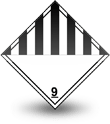
List of groups of particularly hazardous goods according to GOST 19433-88
- Explosives;
- Radioactive substances;
- Non-flammable non-poisonous oxidizing gases;
- Oxidizing poisonous gases;
- Poisonous gases, oxidizing or corrosive;
- Flammable liquids with a flash point of less than minus 18 °C, poisonous;
- Flammable liquids with a flash point of less than minus 18 °C, corrosive;
- Flammable liquids with a flash point of from minus 18 °C to plus 23 °C, corrosive;
- Flammable liquids with a flash point from minus 18 °C to plus 23 °C, poisonous and/or corrosive;
- Flammable solids are caustic and/or corrosive;
- Flammable solids that self-decompose at a temperature not exceeding 50 °C with a risk of package rupture;
- Spontaneously combustible solids, poisonous;
- Flammable solids, caustic and/or corrosive;
- Substances emitting flammable gases when interacting with water, flammable;
- Substances emitting flammable gases when interacting with water, flammable and poisonous;
- Substances emitting flammable gases when interacting with water, flammable, caustic and/or corrosive;
- Oxidizing substances, poisonous, caustic and/or corrosive;
- Organic peroxides, explosive, self-decomposing at temperatures not exceeding 50 °C;
- Organic peroxides self-decomposing at temperatures above 50°C;
- Explosive organic peroxides;
- Organic peroxides without additional hazards;
- Organic peroxides are corrosive to the eyes;
- Organic peroxides, flammable;
- Organic peroxides, flammable, corrosive to the eyes;
- Poisonous substances, volatile, without additional hazards;
- Poisonous substances, volatile, flammable, with a flash point slightly above 23 °C;
- Poisonous substances, volatile flammable, with a flash point of more than 23 °C, but not exceeding 61 °C;
- Toxic substances, volatile, caustic and (or) corrosive;
- Caustic and (or) corrosive, acidic, toxic and oxidizing;
- Caustic and (or) corrosive, having acidic properties, oxidizing;
- Caustic and (or) corrosive, having acidic properties, poisonous;
- Caustic and (or) corrosive, having basic properties, flammable, with flash a point from 23 °C to 61 °C;
- Caustic and (or) corrosive, having basic properties, oxidizing;
- Caustic and (or) corrosive various, poisonous and oxidizing;
- Caustic and (or) corrosive various, flammable, with a flash point of not exceeding 23 °C;
- Caustic and (or) corrosive various, flammable, with a flash point from 24 °C to 61 °C;
- Caustic and (or) corrosive various, poisonous.
In addition to this agreement, there are the other agreements for the transportation of hazardous goods in Europe:
IMDG is a contract for the carriage of hazardous goods by sea.
ICAO-TI is a contract for the carriage of hazardous goods by air.
RID is an agreement on the carriage of hazardous goods by rail. A special UN list of hazardous substances (containing more than 3000 items) has been created. Each hazardous substance included in this list has a four-digit identification number according to the UN list of hazardous substances. It can be used to find out the exact name of the hazardous substance being transported.
It is allowed to transport a hazardous substance of one class only at a time according to the rules intended for it.
These classes of hazardous goods are formed by:
1. The main hazard posed by the substance during its transportation.
2. Physical state of the substance during transportation (solid, liquid, gaseous).
If a substance features more than one hazard, the contract shall specify the main and additional hazards. Artificially created hazards shall not be taken into account.
The entire list of hazardous substances is divided into 13 classes with the numbering from 1 to 9.
Types of hazards
- Explosive hazard;
- Fire hazard;
- Toxicity;
- Causticity (corrosiveness);
- Radioactivity;
- Oxidation.
Cargoes are divided into hazard classes according to the ADR contract classification:
Class 1 – explosive materials and objects;
Class 2 – compressed, liquefied and dissolved gases under pressure;
Class 3 – flammable liquids;
4.1 class – flammable solids;
4.2 class – flammable substances;
4.3 class – substances emitting flammable gases when in contact with water;
5.1 class – oxidizing substances;
5.2 class – organic peroxides;
6.1 class – toxic substances;
6.2 class – animal by-products and infectious substances;
Class 7 – radioactive materials;
Class 8 – corrosive substances;
Class 9 – other hazardous substances.
ADR documents
Entries to consignment notes. The consignment note must be written in the state language of the consignor. If this language is not English, French, German, it shall be additionally written in one of them.
When recording the name of the hazardous goods transported in the consignment note, the following information shall also be provided:
- UN… (or ANO…) identification number (example: 1831).
- full name of the hazardous goods.
- class of the main hazard (called the number of the main hazard symbol) and the class of additional hazard, if any (indicating the number of the additional hazard symbol in brackets, e.g. 8 (6.1)), and the packaging group, if any.
Hazardous waste
Hazardous waste containing substances on the UN Hazardous Goods List must be transported as hazardous goods. Example of entry: Waste, UN 1125, butylamine, 3 (8), II. Written instruction for the driver transporting hazardous goods – Emergency Card. This card shall be drawn up by the consignor of the cargo and handed over to the driver before loading.
This card shall be drawn up for each hazardous goods or group of hazardous goods with the same hazard (if the goods belong to the same class with the same hazard). This card must be kept in the cab of the vehicle in an accessible place (for example, in Sweden it is kept in the driver’s door pocket).
This card is needed for the driver and rescue services as it contains information about the hazardous goods transported and emergency response actions. The card must be issued in the languages of the countries crossed by the route of transportation in a language understandable to the driver (in each language of the countries included in the ADR agreement). The consignor shall agree on the route with the carrier to check the languages of the card. He informs the carrier in advance about the cargo, route, additional means of protection and equipment. The driver shall not be responsible for the content of the card.
Types of packaging and labeling
The cargo consignor shall choose the packaging of hazardous goods. Double and non-disassemblable packaging shall be used. If the packaging is disassemblable, then it is combined. An IBC (Intermediate Bulk Container), a container with an average capacity up to 3000 liters, is often used. Such containers are considered packages.
It is required to check the labeling of the cargo and the availability of a hazard sign, i.e. a diamond with a rib length slightly exceeding 100 mm. It is obligatory to place all hazard signs on one side of the package. Reliability of packaging shall be indicated by Latin letters X, Y and Z, where X is very reliable.
Packing groups I, II, III. Y – simply reliable. Packing group II and III. Z – with satisfactory reliability. The packing group is III only. It is required to compare the packing group and reliability.
 EN
EN
